Items filtered by date: July 2025
Preventing Falls and Foot Injuries in the Elderly
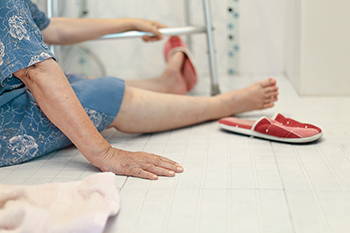
Falling accidents may increase with age, and preventing falls and related foot injuries begins with strengthening exercises to improve leg and foot muscles, enhancing overall stability. Balance training helps maintain coordination and confidence while walking. Using a cane or walker can offer vital support, especially for those with limited mobility. Changing footwear to supportive, non-slip shoes greatly reduces the risk of slipping. It is also important to review medications that may cause dizziness or instability. A podiatrist can evaluate foot health, recommend appropriate devices, and create personalized care plans for seniors to improve balance and prevent falls. If you have endured a foot or ankle injury from falling, it is suggested that you consult a podiatrist who can treat various foot conditions and guide you on effective fall prevention tips.
Preventing falls among the elderly is very important. If you are older and have fallen or fear that you are prone to falling, consult with Larry J. Kipp, DPM from Coastal Podiatry Center. Our doctor will assess your condition and provide you with quality advice and care.
Every 11 seconds, an elderly American is being treated in an emergency room for a fall related injury. Falls are the leading cause of head and hip injuries for those 65 and older. Due to decreases in strength, balance, senses, and lack of awareness, elderly persons are very susceptible to falling. Thankfully, there are a number of things older persons can do to prevent falls.
How to Prevent Falls
Some effective methods that older persons can do to prevent falls include:
- Enrolling in strength and balance exercise program to increase balance and strength
- Periodically having your sight and hearing checked
- Discuss any medications you have with a doctor to see if it increases the risk of falling
- Clearing the house of falling hazards and installing devices like grab bars and railings
- Utilizing a walker or cane
- Wearing shoes that provide good support and cushioning
- Talking to family members about falling and increasing awareness
Falling can be a traumatic and embarrassing experience for elderly persons; this can make them less willing to leave the house, and less willing to talk to someone about their fears of falling. Doing such things, however, will increase the likelihood of tripping or losing one’s balance. Knowing the causes of falling and how to prevent them is the best way to mitigate the risk of serious injury.
If you have any questions, please feel free to contact our office located in New Port Richey, FL . We offer the newest diagnostic and treatment technologies for all your foot care needs.
What to Know About Turf Toe Injuries
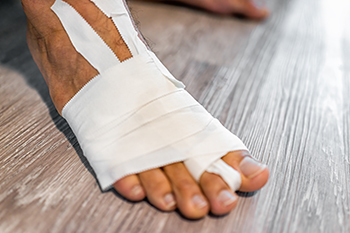
Turf toe is a sprain of the big toe joint that usually happens when the toe bends too far upward. It often occurs during sports or quick movements, especially on hard surfaces like artificial turf. The injury can be sudden or develop slowly from repeated stress. Symptoms include pain, swelling, and limited movement in the toe. Pushing off the foot may feel difficult, and the joint can become stiff or tender to the touch. While mild cases may heal with rest, more severe sprains might need bracing or therapy. Ignoring turf toe can lead to long-term joint problems or reduced performance. If your big toe hurts after activity or does not improve with rest, it is suggested that you see a podiatrist for a proper diagnosis and care plan that supports recovery and prevents reinjury.
Sports related foot and ankle injuries require proper treatment before players can go back to their regular routines. For more information, contact Larry J. Kipp, DPM of Coastal Podiatry Center. Our doctor can provide the care you need to keep you pain-free and on your feet.
Sports Related Foot and Ankle Injuries
Foot and ankle injuries are a common occurrence when it comes to athletes of any sport. While many athletes dismiss the initial aches and pains, the truth is that ignoring potential foot and ankle injuries can lead to serious problems. As athletes continue to place pressure and strain the area further, a mild injury can turn into something as serious as a rupture and may lead to a permanent disability. There are many factors that contribute to sports related foot and ankle injuries, which include failure to warm up properly, not providing support or wearing bad footwear. Common injuries and conditions athletes face, including:
- Plantar Fasciitis
- Achilles Tendinitis
- Achilles Tendon Rupture
- Ankle Sprains
Sports related injuries are commonly treated using the RICE method. This includes rest, applying ice to the injured area, compression and elevating the ankle. More serious sprains and injuries may require surgery, which could include arthroscopic and reconstructive surgery. Rehabilitation and therapy may also be required in order to get any recovering athlete to become fully functional again. Any unusual aches and pains an athlete sustains must be evaluated by a licensed, reputable medical professional.
If you have any questions please feel free to contact our office located in New Port Richey, FL . We offer the newest diagnostic and treatment technologies for all your foot and ankle needs.
See Your Foot Specialist Regularly If You Work On Your Feet
Exercises Can Reduce Risk of Running Injuries
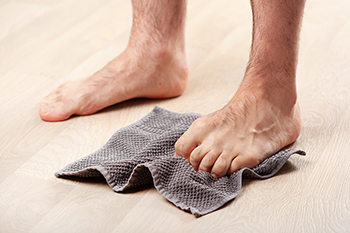
Runners often put significant stress on the feet, and poor mechanics or muscle imbalances can increase the risk of overuse injuries. Strengthening and stretching exercises can help reduce strain on foot structures, like the plantar fascia, Achilles tendon, and intrinsic foot muscles. Routines that focus on calf flexibility, toe control, and arch stability can enhance shock absorption and improve foot alignment during running. Having tight calves or weak foot muscles may contribute to problems like plantar fasciitis or Achilles tendinitis. Similarly, imbalances in the lower leg may affect ankle stability and increase the risk of sprains. Exercises like calf raises, towel scrunches with the toes, and controlled ankle movements can strengthen foot and ankle structures. A podiatrist can evaluate your gait, identify structural risks, and recommend exercises or orthotic devices as part of a comprehensive treatment plan. If you are a runner and experience foot pain, it is suggested that you schedule an appointment with a podiatrist for a diagnosis, treatment and effective running injury prevention tips.
Exercising your feet regularly with the proper foot wear is a great way to prevent injuries. If you have any concerns about your feet, contact Larry J. Kipp, DPM of Coastal Podiatry Center. Our doctor will treat your foot and ankle needs.
How to Prevent Running Injuries
Many common running injuries are caused by overuse and overtraining. When the back of the kneecap starts wearing out and starts causing pain in your knee, this is commonly referred to as runner’s knee. Runner’s knee is a decrease in strength in your quadriceps and can occur if you’re not wearing properly fitted or supporting shoes. To prevent runner’s knee, focusing on hip strengthening is a good idea, as well as strengthening your quads to keep the kneecaps aligned.
What Are Some Causes of Running Injuries?
- One cause of a common running injury is called iliotibial band syndrome.
- Plantar fasciitis is also another common injury.
- Stress fractures can occur from overtraining, lack of calcium, or even your running style.
Best Ways to Prevent Running Injuries
- Wear footwear that fits properly and suits your running needs.
- Running shoes are the only protective gear that runners have to safeguard them from injury.
- Make a training schedule. Adding strengthening exercises as well as regular stretching can help keep you strong and limber and can lessen the possibility of injuries.
- Stretching keeps muscles limber; this will help you gain better flexibility.
If you have any questions please feel free to contact our office located in New Port Richey, FL . We offer the newest diagnostic and treatment technologies for all your foot and ankle needs.
How a Podiatrist Can Help Manage Gout
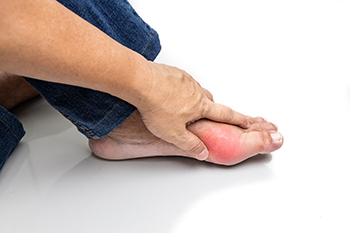
Gout is a painful type of arthritis that often begins in the big toe but can also affect other joints in the foot or ankle. It results from a buildup of uric acid crystals in the joints, which may lead to intense pain, swelling, and redness. A podiatrist can help manage gout in the feet by first confirming the diagnosis through a physical exam, and, when needed, testing fluid from the affected joint. During gout flare-ups, a podiatrist can provide targeted treatment to relieve inflammation and reduce discomfort in the affected foot or ankle. If gout becomes chronic, this type of doctor can monitor long-term joint changes and may recommend custom footwear or orthotics to reduce pressure on sensitive joints. In rare cases, surgery may be considered to remove hardened uric acid deposits, called tophi, or to repair joint damage caused by repeated attacks. If you have recurrent foot pain attributed to gout, it is suggested that you schedule an appointment with a podiatrist for help in managing this condition.
Gout is a foot condition that requires certain treatment and care. If you are seeking treatment, contact Larry J. Kipp, DPM from Coastal Podiatry Center. Our doctor will treat your foot and ankle needs.
What Is Gout?
Gout is a type of arthritis caused by a buildup of uric acid in the bloodstream. It often develops in the foot, especially the big toe area, although it can manifest in other parts of the body as well. Gout can make walking and standing very painful and is especially common in diabetics and the obese.
People typically get gout because of a poor diet. Genetic predisposition is also a factor. The children of parents who have had gout frequently have a chance of developing it themselves.
Gout can easily be identified by redness and inflammation of the big toe and the surrounding areas of the foot. Other symptoms include extreme fatigue, joint pain, and running high fevers. Sometimes corticosteroid drugs can be prescribed to treat gout, but the best way to combat this disease is to get more exercise and eat a better diet.
If you have any questions please feel free to contact our office located in New Port Richey, FL . We offer the newest diagnostic and treatment technologies for all your foot and ankle needs.
Understanding Morton's Neuroma
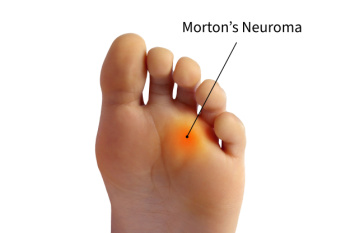
Morton's neuroma is a painful condition caused by the thickening of tissue surrounding a nerve between the toes, most commonly between the third and fourth toes. This thickening results from irritation, pressure, or injury, often linked to wearing tight or high-heeled shoes or from repetitive stress. Symptoms include sharp, burning pain in the ball of the foot, numbness, tingling, or a feeling of a pebble stuck under the foot. The affected area may be tender to touch, and discomfort typically worsens when walking or wearing tight footwear. A podiatrist diagnoses Morton's neuroma through a physical exam and may use imaging tests like ultrasound or MRI scans to confirm. Treatment options include changing footwear, custom orthotics, corticosteroid injections, or targeted exercises. In severe cases, surgery may be necessary to remove the affected or surrounding tissue. If you have pain in this part of your foot, it is suggested that you schedule an appointment with a podiatrist who can accurately diagnose and treat Morton's neuroma.
Morton’s neuroma is a very uncomfortable condition to live with. If you think you have Morton’s neuroma, contact Larry J. Kipp, DPM of Coastal Podiatry Center. Our doctor will attend to all of your foot care needs and answer any of your related questions.
Morton’s Neuroma
Morton's neuroma is a painful foot condition that commonly affects the areas between the second and third or third and fourth toe, although other areas of the foot are also susceptible. Morton’s neuroma is caused by an inflamed nerve in the foot that is being squeezed and aggravated by surrounding bones.
What Increases the Chances of Having Morton’s Neuroma?
- Ill-fitting high heels or shoes that add pressure to the toe or foot
- Jogging, running or any sport that involves constant impact to the foot
- Flat feet, bunions, and any other foot deformities
Morton’s neuroma is a very treatable condition. Orthotics and shoe inserts can often be used to alleviate the pain on the forefront of the feet. In more severe cases, corticosteroids can also be prescribed. In order to figure out the best treatment for your neuroma, it’s recommended to seek the care of a podiatrist who can diagnose your condition and provide different treatment options.
If you have any questions, please feel free to contact our office located in New Port Richey, FL . We offer the newest diagnostic and treatment technologies for all your foot care needs.


